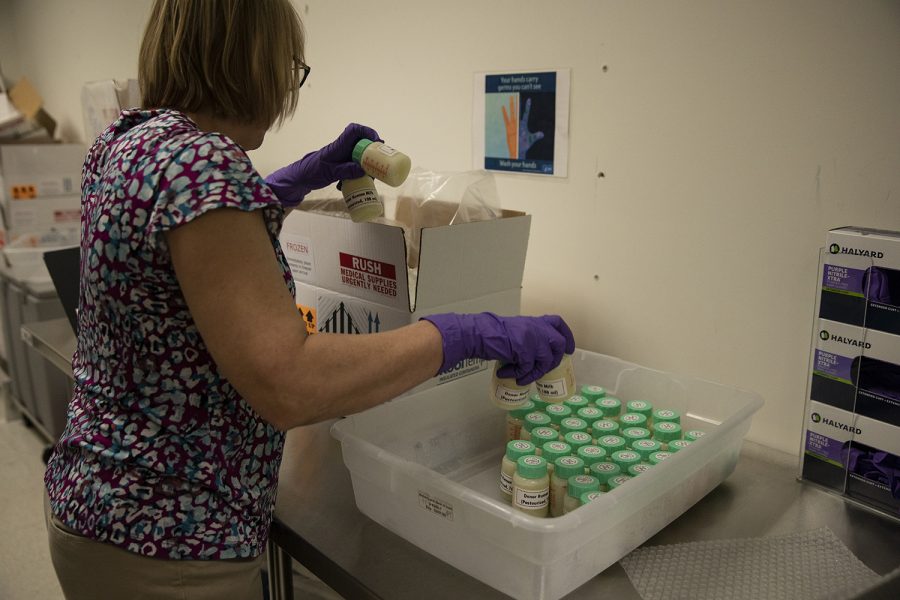Mother’s Milk Bank of Iowa looks to draw in more donors as demand increases
The Mother’s Milk Bank of Iowa distributes over 1,000 ounces of breast milk a day – but organizational directors say they are still in need of more.
Pasteurization Coordinator Ann Jorgensen packs milk to be shipped to an undisclosed location at the Mother’s Milk Bank of Iowa on November 13, 2019. The Bank dispensed to 17 states and distributed almost 224,000 ounces of milk in the previous year. (Ryan Adams/The Daily Iowan)
November 13, 2019
Seventeen years ago, the Mother’s Milk Bank of Iowa began collecting donated breastmilk and distributing it to hospitals around Iowa and the Midwest — now more and more hospitals are adopting the use of donor milk, and the bank needs more to meet the demand.
The Mother’s Milk Bank of Iowa, part of University of Iowa Hospitals and Clinics, collects milk from 37 depots across the states of Iowa, Nebraska, South Dakota, and Wisconsin, with milk distributed to a total of 61 hospitals in 16 states.
Established in 2002, the Mother’s Milk Bank was the first of its kind in the Midwest, said Director Jean Drulis. Donated breast milk is most commonly used to feed premature babies in NICU care, whose mothers cannot yet provide enough milk to feed their child, she added.
Drulis said that, although the bank regularly processes 1,000 ounces of milk a day, there is only enough donated milk for the bank to run on a day-to-day basis. The demand for donated milk is increasing, she said.
“As more and more hospitals are aware of [donor milk], they’re ordering more. As more babies and parents are aware of it, more babies are getting donor milk,” Drulis said. “The demand is increasing because more hospitals and outpatient families are ordering it.”
Twenty percent of milk donated goes to UIHC, while the remaining 80 percent goes to other hospitals in the region or to mothers nursing at home, Drulis said.
Milk is shipped to the bank’s offices in Coralville, where it is pasteurized and then delivered to hospitals in a Suburban known as the “Milk Wagon,” she added.
RELATED: Liberty High senior becomes DeGowin Blood Center’s first two-time Gallon Graduate
Drulis said the bank is searching for more donors to meet the increased demand for donated milk.
“We are desperately in need of more donors because of the demand — when there’s a demand, we want to meet it,” she said. “We want those babies to receive human milk over the alternative so we’re searching far and wide to find more donors to feed the babies.”
Drulis said the rise of for-profit milk banking — where donors are paid for their milk — could contribute to the lack of donors, and so could the sharing of breast milk without going through an official bank between mothers.
Tarah Colaizy, a professor of pediatrics at Carver College of Medicine, said the use of donor milk in hospitals has increased rapidly in the last 10 years.
“We’ve known for a long time that feeding small premature infants with their mothers, or human milk, results in better outcomes for these kids,” she said. “They have lower rates of infection, blood infections, and severe gut infections.”
Colaizy said babies fed with breast milk often have better developmental outcomes than babies fed with formula.
“The developmental testing results of kids fed from their mom’s own milk are better when they’re 2 or 3 years old, some data, [shows] up to 7 to 10 years old, than babies fed with formula,” she said.
Ann Jurgensen, pasteurization coordinator for the Mother’s Milk Bank said women who produce more milk than their own babies often want to share their milk for a good cause.
“I think a lot of people, if they have extra milk, they do want to donate it to a good cause,” Jurgensen said.






